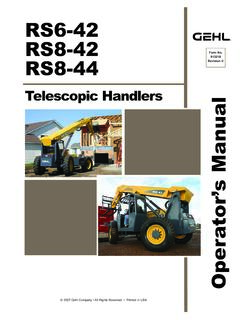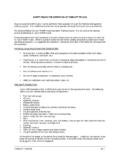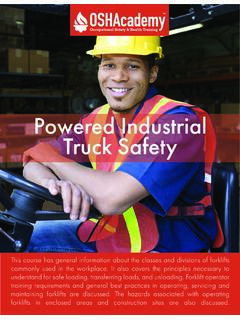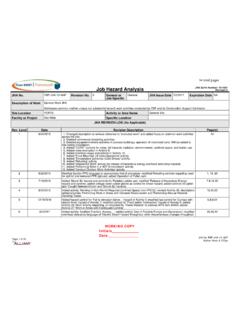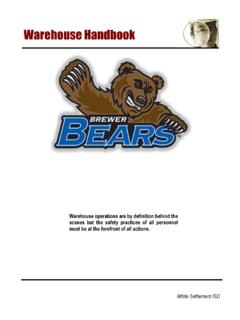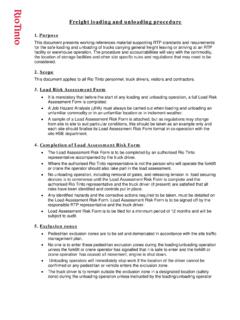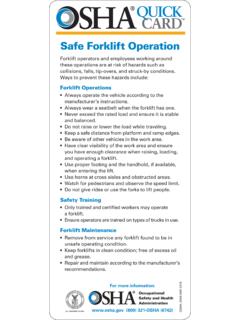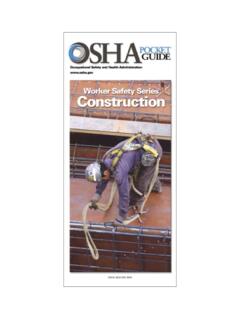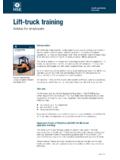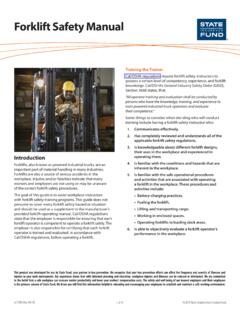Transcription of M30/40/50-2T H L M30/40/50-4T H L
1 CONTENT. MANITOU NORTH AMERICA, INC. 6401 Imperial Drive Waco, TX 76712-6803. For Parts Orders contact your Manitou North America Dealer or call: Manitou North America Parts Dept. (800) 425-3727 or (254) 799-0232. Parts Dept. Fax (254) 867-6504. Email address: M30/40/50-2T H L. M30/40/50-4T H L. HYDROSTATIC & 4-SPEED. TRANSMISSIONS. - TIER III TURBO ENGINES - OPERATOR/SERVICE. MANUAL. FORKLIFT S/N: 757730 & above THIS OPERATOR'S MANUAL MUST BE KEPT IN THE LIFT truck AND MUST BE READ AND. UNDERSTOOD BY THE OPERATOR. CATALOG 809817. R11 - 10. CONTENT. CONTENT. M-SERIES TIER III. FORKLIFT MODEL DESCRIPTION. M 30 -2T H L 100. FORKLIFT OPTIONAL CAB HEIGHTS*. MODEL 100 - 100 IN. CAB. 81 - 81 IN. CAB. 77 - 77 IN. CAB. FORKLIFT RATED. CAPACITY FRAME LEVELING. 30 - 6,000 LBS (Available on 100 Models only). 40 - 8,000 LBS L - FRAME LEVELING. 50 - 10,000 LBS OMITTED - NO LEVELING. 60 - 12,000 LBS. FORKLIFT. DRIVETRAIN. TRANSMISSION. -2 - 2WD (2 WHEEL DRIVE). H - HYDROSTATIC. -4 - 4WD (4 WHEEL DRIVE).
2 OMITTED - 4-SPEED/CONVERTER. -T - Turbo Engine (standard). NOTE: Lift trucks equipped with the TIER III Engine have wheels that are painted Manitou silver and the TURBO' logo displayed on the fuel tank and hydraulic oil tank. * Dimensions may vary depending on tires, additional options, etc. CONTENT. M- SERIES. POWERTRAIN COMPONENT. IDENTIFICATION. TURNER 4--SPEED TRANSMISSION. IDENTIFICATION PLATE. (LEFT HAND SIDE OF TRANSMISSION). HYDROSTATIC MOTOR. IDENTIFICATION PLATE. (BOTTOM SIDE OF PUMP). HYDROSTATIC (TRANSMISSION) PUMP 2--SPEED GEARBOX. IDENTIFICATION PLATE (HYDROSTATIC MODELS). (BOTTOM SIDE OF PUMP) IDENTIFICATION PLATE. (RIGHT SIDE OF GEARBOX). MAST SERIAL NO. PLATE. (RIGHT SIDE OF MAST). MANUFACTURER'S. SERIAL NO. (STAMPED VERTICALLY -- FRONT RIGHT SIDE OF. FORKLIFT FRAME). MANUFACTURER'S. SERIAL NO. PLATE. (INSIDE THE CAB) FRONT DRIVE AXLE. REAR 4WD STEER AXLE. IDENTIFICATION PLATE. IDENTIFICATION PLATE. (FRONT CENTER UPPER HALF OF. (REAR CENTER, UPPER HALF OF.))
3 ENGINE IDENTIFICATION PLATE AXLE). AXLE). (RIGHT HAND SIDE OF ENGINE BLOCK). CONTENT. - INTRODUCTION TO SAFETY - - ROUGH TERRAIN FORKLIFT truck . GENERAL SAFETY STANDARDS - - - - - - - - - - - I. - SAFETY MESSAGES - - - - - - - - - - - - - - - - - - - - - - - - - - - - - - - - - - VII. - SAFETY DECALS - - - - - - - - - - - - - - - - - - - - - - - - - - - - - - - - - - - - - VIII. - TABLE OF CONTENTS - - - - - - - - - - - - - - - - - - - - - - - - - - - - - - - - - XV. CONTENT. CONTENT. ROUGH TERRAIN FORKLIFT truck . GENERAL SAFETY STANDARDS. I. CONTENT. ROUGH TERRAIN FORKLIFT truck GENERAL SAFETY STANDARDS. STUDY THE OPERATOR/SERVICE MANUALS. The information in this manual provides general instructions for the safe operation and maintenance of your forklift truck . This information is vital and must be clearly understood by the operator and serviceman. Study this manual and the Rough Terrain Forklift Safety Manual (part no. 422494) thoroughly and carefully before operating or servicing your forklift.
4 Contact your dealer or Manitou North America, Inc. if you have any ques- tions concerning your forklift, its operation, service or parts. Keep both manuals in the literature box on the forklift available for reference. If either manual becomes illegible or is missing, contact your dealer for replace- ments immediately. This manual cannot cover every situation that might result in an accident. It is the respon- sibility of the operator to always remain alert for potential hazards and be prepared to avoid them! ADDITIONAL RECOMMENDED LITERATURE: ANSI / ITSDF is the national consensus standard for rough terrain forklift trucks . It contains rules about forklift safety, maintenance, safe operation, training, and supervision. Forklift owners should learn this standard and make it available for their operators, service personnel, and supervisors. These standards can be obtained, free of charge, from the Industrial truck Standards Development Foundation (ITSDF) on their website at The following references are examples from the standard, addressing forklift opera- tors: A.
5 OPERATOR TRAINING QUALIFICATIONS. 1.) The user shall ensure that operators understand that safe operation is the operator's responsibility. The user shall ensure that operators are knowledgeable of, and observe, all safety rules and practices. 2.) Create an effective operator training program centered around user company's policies, operating condi- tions, and rough terrain forklift trucks . The program should be presented completely to all new operators and not be condensed for those claiming previous experience. 3.) Information on operator training is available from several sources, including rough terrain forklift truck manu- facturers, users, government agencies, etc. 4.) An operator training program should consist of the following: a.) careful selection of the operator, considering physical qualifications, job attitude, and aptitude;. b.) emphasis on safety of stock, equipment, operator, and other personnel;. c.) citing of rules and why they were formulated.
6 D.) basic fundamentals of rough terrain forklift truck and component design as related to safety, , (N-m) loading, mechanical limitations, center of gravity, stability, etc.;. e.) introduction to equipment, control locations, and functions. Explain how they work when used properly and problems when used improperly. f.) supervise practice on operating course remote from normal activity and designed to simulate actual operations , , lumber stacking, elevating shingles to the roof, etc.;. g.) oral, written, and operational performance tests and evaluations during and at completion of the course;. h.) refresher courses, which may be condensed versions of the primary course, and periodic on job operator evaluation;. i.) understanding of nameplate data and operator instructions and warning information appearing on the rough terrain forklift truck . B.) GENERAL SAFETY PRACTICES. 1.) Rough terrain forklift trucks can cause injury if improperly used or maintained. 2.) Only authorized operators trained to adhere strictly to all operating instructions shall be permitted to operate rough terrain forklift trucks .
7 Unusual operating conditions may require additional safety precautions, training, and special operating instructions. 3.) Modifications and additions which affect capacity or safe operation shall not be preformed without the man- ufacturer's prior written approval. Where such authorization is granted, capacity, operation, and maintenance instruction plates, tags, or decals shall be changed accordingly. 4.) If the rough terrain forklift truck is equipped with front end attachment(s) or optional forks, the user shall see that the truck is marked to identify the forks or attachment(s), show the approximate weight of the truck and fork or attachment combination, and show the capacity of the truck with forks or attachment(s) at maximum elevation with load laterally centered. 5.) The user shall see that all nameplates and caution and instruction markings are in place and legible. 6.) The user shall consider that changes in load dimension may affect rough terrain forklift truck capacity.
8 II. CONTENT. ROUGH TERRAIN FORKLIFT truck GENERAL SAFETY STANDARDS (cont.). B.) GENERAL SAFETY PRACTICES (cont.). 7.) Where steering can be accomplished with either hand and the steering mechanism is of a type that prevents road reactions from causing the handwheel to spin (power steering or equivalent), steering knobs may be used. When used, steering knobs shall be of a type that can be engaged by the operator's hand from the top and shall be within the periphery of the steering handwheel. 8.) Experience has shown that rough terrain forklift trucks which comply with stability requirements are stable when properly operated. However, improper operation, faulty maintenance, or poor housekeeping may con- tribute to a condition of instability and defeat the purpose of the requirements. 9.) Users shall give consideration to special operating conditions. The amount of forward and rearward tilt to be used is governed by the application. Although the use of maximum rearward tilt is allowable under certain conditions, such as traveling with the load lowered, the stability of a rough terrain forklift truck as determined by standardized tests does not encompass consideration for excessive tilt at high elevations or the operation of trucks with excessive off-center loads.
9 10.) Some of the conditions which may affect stability are ground and floor conditions, grade, speed, loading (rough terrain forklift trucks equipped with attachments behave as partially loaded trucks even when operated without a load on the attachment), dynamic and static forces, improper tire inflation, and the judgement exer- cised by the operator. C.) OPERATING SAFETY rules AND PRACTICES. 1.) Safe operation is the responsibility of the operator. 2.) This equipment can be dangerous if not used properly. The operator shall develop safe working habits and also be aware of hazardous conditions in order to protect himself, other personnel, the rough terrain forklift truck , and other material. 3.) The operator shall be familiar with the operation and function of all controls and instruments before under- taking to operate the rough terrain forklift truck . 4.) Before operating any rough terrain forklift truck , truck operators shall have read and be familiar with the operator's manual for the particular truck being operated.
10 5.) Before starting to operate the rough terrain forklift truck : a.) be in operating position and fasten seat belt;. b.) place directional controls in neutral;. c.) apply brakes;. d.) start engine. 6.) Do not start or operate the rough terrain forklift truck , any of its functions, or attachments from any place other than the designated operator's position. 7.) Keep hands and feet inside the operator's designated area or compartment. Do not put any part of the body outside the operator compartment of the rough terrain forklift truck . 8.) Never put any part of the body into the mast structure or between the mast and the rough terrain forklift truck . 9.) Never put any part of the body within the reach mechanism of the rough terrain forklift truck or other attach- ments. 10.) Understand rough terrain forklift limitations and operate the truck in a safe manner so as not to cause injury to personnel. 11.) Do not allow anyone to stand or pass under the elevated portion of any rough terrain forklift truck , whether empty or loaded.
